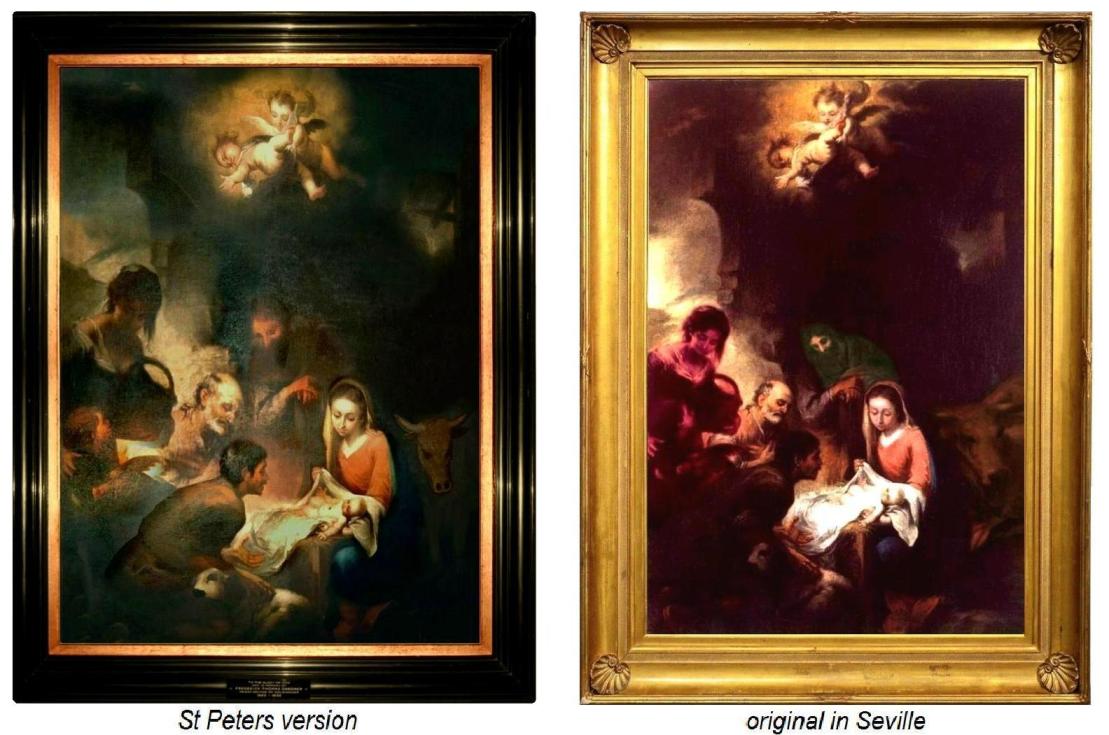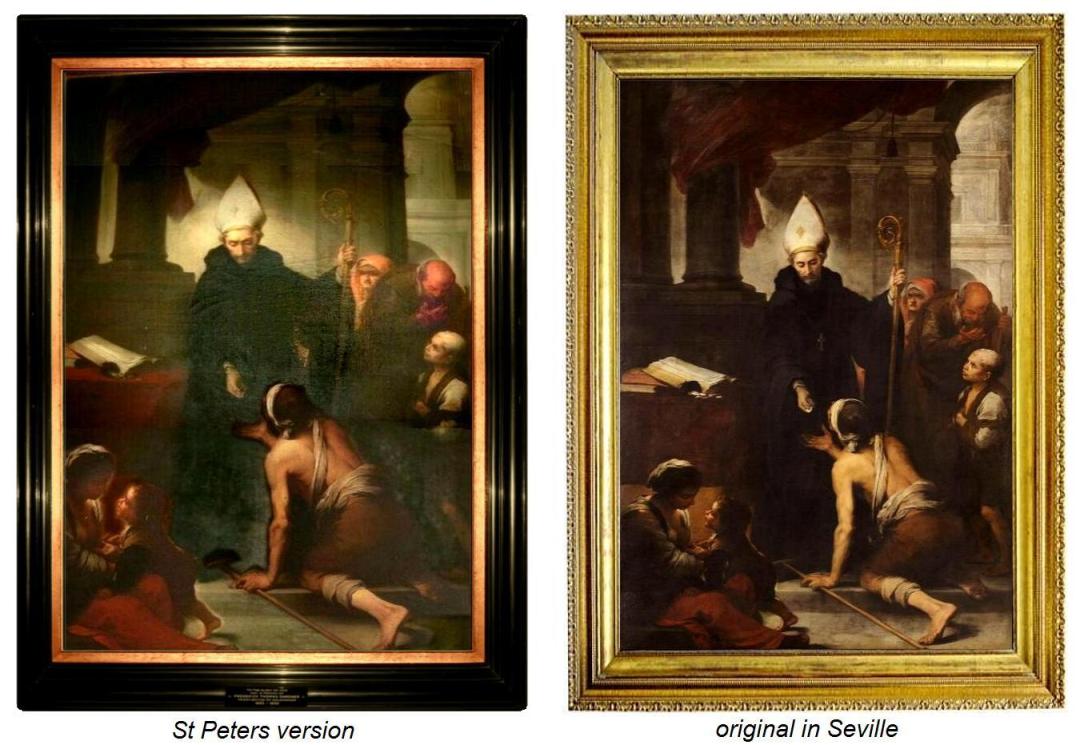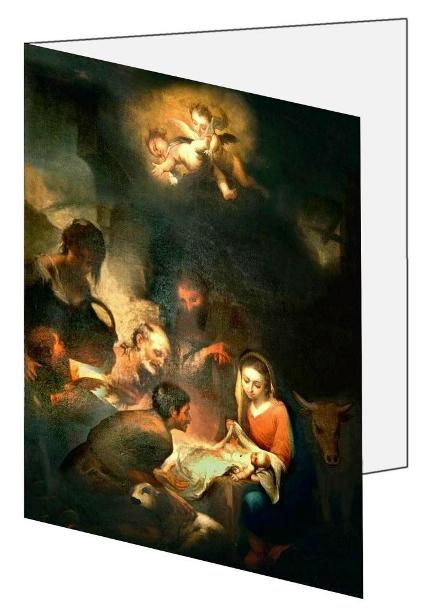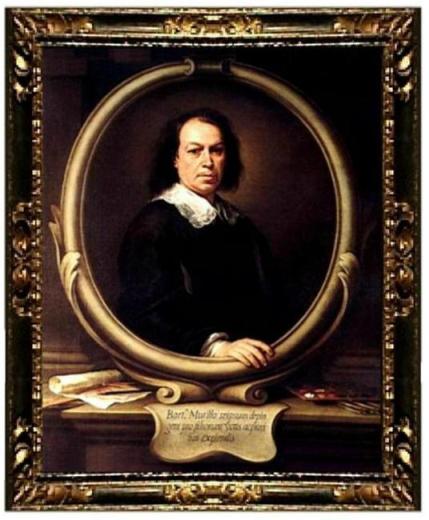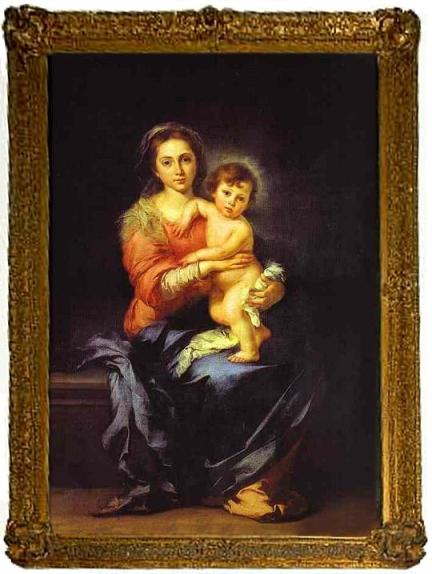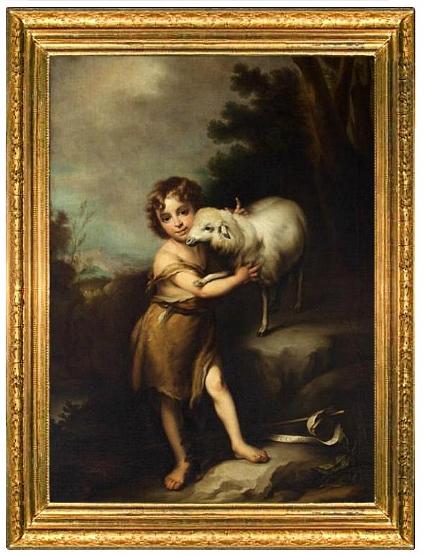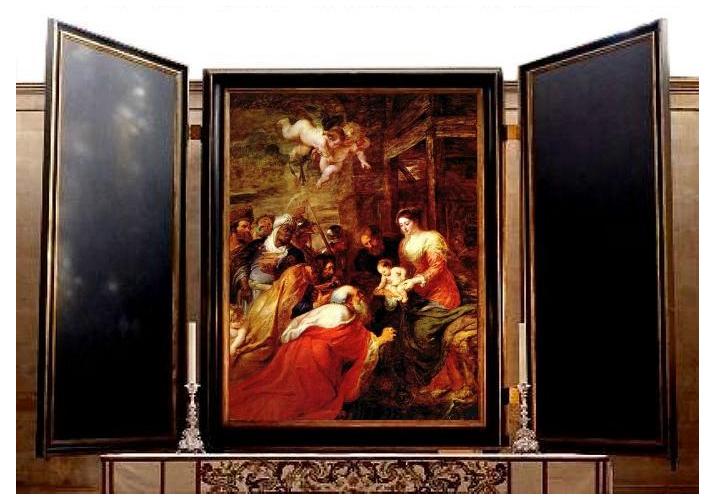The Oil Paintings in St
Peters Church
The
two large oil paintings hanging in St Peters Church
were in The Rectory for many years when the Revd. Gardner was in residence, and were moved to the
Church for safe keeping during World War 2 when the house
was occupied by the army and adjacent The Park became the Searchlight
Camp in the Park. The two pictures were then donated to the Church by the
Revd. Gardner’s family after his death and the house was put up for sale. They
have recently been assessed by an Essex based art historian with a special
interest in Spanish paintings as 19th century copies of two very well know
works by the 17th century Spanish artist Bartolome Esteban Murillo (1618-1682).
Today the originals are housed in Museo de Bellas Artes, in Seville.
The versions in St
Peters Church are slightly smaller, are darkened by age, smoke and deteriorating
varnish, having been hung over fireplaces in the Rectory for many years.
However, they are remarkably similar to the originals. They are not signed,
dated, or have titles and it is not know how long they had been in the Rectory
or how they were acquired and came to be in Goldhanger. The Murillo originals
were originally commissioned in circa 1668 for the Capuchin Church in Seville.
The titles of the paintings are The
Adoration of the Shepherds and St.
Thomas of Villanueva Distributing Alms.The paintings are shown here
alongside the Murillo originals...
|
St. Thomas of
Villanueva Distributing Alms |
|
||
|
|
|||
|
(a
digitally enhanced image) |
|
||
|
The
Adoration of the Shepherds painting
in St Peters which is a classic nativity scene has been used as a Christmas card
on at least three occasions in the recent past, twice locally to raise funds
for the Church, and in 2020 it was used by the Friends of Essex Church Trust...
|
|
|
|
to
see online HD versions of the original paintings visit...
and...
the
following extracts about the paintings are taken from... www.historyandarts.com
The Adoration of the Shepherds
This
version of Adoration of the Shepherds was once in the third chapel along the
right nave in the Capuchin church in Seville. It is one of the most striking
scenes in the series both because of its baroque composition and the harmonious
effect of the way parts of the image have been set against the light. The
Virgin opens the blanket to show the newborn baby to the group of shepherds,
made up of an old man, a younger man and woman and a child, thus capturing the
cycle of life. Each of the shepherds offers a gift to the new parents - who
also gaze at the child with rapt expressions. In the upper part of the image
there is a small celestial vision of glory made up of two angels in opposing
foreshortened postures, creating a greater sense of movement. The figures'
expressions have been taken from everyday life and the Virgin or the woman
gazing at the newborn baby are particularly beautiful images.
The
whole scene exudes gentleness and simplicity without renouncing the spirituality
that is necessary in a holy image. The composition is organised around
diagonals which gives a sense of rhythm and movement. These diagonals are
reinforced by the illumination produced by a diagonal beam that penetrates the
image from the left, filling the main scene with light and leaving the rest in
shadow. Thanks to the light and the rapid, impasted application of colour
Murillo creates an aerial sensation that is difficult to equal.
St. Thomas of Villanueva Distributing Alms
Murillo
painted this Saint Thomas for the last chapel along the right nave in the
Capuchin monastery in Seville. The main figure in this image is not a
Franciscan monk as in the other images painted for the church. Saint Thomas was
an Augustinian saint whose presence was justified because of his charitable
deeds - giving alms was one of the Franciscan order's main activities. Another
reason for including Saint Thomas in the decorative scheme was that he was from
Valencia and in the Capuchin community in Seville there were a number of friars
from this region who were particularly devoted to the saint.
Saint
Thomas is depicted in an architectural interior which allows Murillo to create
a magnificent sense of depth by alternating planes of light and shade. The
saint presides the scene, having abandoned his theological studies - his books
can be seen on the table on the left - to devote himself to charitable acts,
giving alms to a number of beggars. A crippled man kneels at the saint's feet,
stretching out his hand to take the coins, creating a striking foreshortening.
On the right there are more beggars. A young boy looks gratefully at the saint,
an old man looks at his hand to check that he still has his coin while the old
woman behind him looks worried. In the foreground on the left is one of
Murillo's most attractive groups of figures with a woman and her son.
Biographical details of Bartolomé Murillo
extracts
from... http://www.wga.hu/frames-e.html?/bio/m/murillo/biograph.html
MURILLO,
Bartolomé Esteban, 1617-1682
Murillo
was a Spanish painter active for almost all his life in his native Seville.
After making his reputation with a series of eleven paintings on the lives of
Franciscan saints for the Franciscan monastery in Seville (1645-46) The
pictures are now dispersed in Spain and elsewhere. He displaced Zurbaran as the
city's leading painter and was unrivalled in this position for the rest of his
life.
Most
of his paintings are of religious subjects, appealing strongly to popular piety
and illustrating the doctrines of the Counter-Reformation church, above all the
Immaculate Conception, which was his favourite theme. His mature style was very
different to that seen in his early works; it is characterized by idealized
figures, soft, melting forms, delicate colouring, and sweetness of expression
and mood. The term 'estilo vaporoso' (vaporous style) is often used of it.
Murillo also painted genre scenes of beggar children that have a similar
sentimental appeal, but his fairly rare portraits are strikingly different in
feeling - much more sombre and intellectual.
This
self-portrait of Murillo is in the National Gallery in London...
_________________________
Murillo’s
most popular nativity scene and other paintings were widely copied in the
Victorian period and a considerable number of these remain in stately homes,
museums and churches around the world. A search for Murillo in... www.nationaltrustcollections.org.uk indentifies 70 of his paintings spread around
the UK. In East Anglia there is known to be two: one in St Martin’s Church,
Chipping Ongar, and one in Felbrigg Hall, Norfolk, both are copies...
Madonna and Child Infant John the Baptist with
Lamb .
St. Martin’s Church, Ongar Felbrigg Hall, Norfolk
_________________________
Numerous
variants of the Adoration of the
Shepherds have been produced by other well know artists over the centuries.
Here is a small selection...
The
Rubens painting above is in Corpus Christi College at Oxford but perhaps the
most famous version is Ruben’s Adoration of the Magi which is the altar piece in Kinks College
Chapel at Cambridge and this painting has a strange local connection – it was
donated to the University in 1961 by Major Alfred Allnatt, a very wealthy
philanthropist who owned Osea Island at the
time...
Due
to the popularity of versions of these paintings in the recent past, copies
have also been made into postage stamps and were most probably used at
Christmas time...
_________________________
back to...
St Peters
Church Revd. Gardner home
